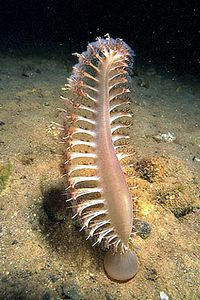
Bioluminescence is the production and emission of light by living organisms. It is a form of chemiluminescence. Bioluminescence occurs widely in marine vertebrates and invertebrates, as well as in some fungi, microorganisms including some bioluminescent bacteria, and terrestrial arthropods such as fireflies. In some animals, the light is bacteriogenic, produced by symbiotic bacteria such as those from the genus Vibrio; in others, it is autogenic, produced by the animals themselves.

The Squaliformes are an order of sharks that includes about 126 species in seven families.

Sea pens are colonial marine cnidarians belonging to the order Pennatulacea. The order Pennatulacea, commonly known as sea pens, are colony-forming benthos belonging within subclass Octocorallia. Sea pens are found worldwide from shallow to deep waters, and they are important components in sandy and muddy environments. Thus far, there has been only one molecular study focusing on the phylogenetic relationships within the order Pennatulacea, which mainly treated deep-sea species, and thus information on shallow water species is still lacking. There are 14 families within the order and 35 extant genera; it is estimated that of 450 described species, around 200 are valid. Sea pens have a cosmopolitan distribution, being found in tropical and temperate waters worldwide, as well as from the intertidal to depths of more than 6100 m. Sea pens are grouped with the octocorals, together with sea whips (gorgonians).
Glowworm or glow-worm is the common name for various groups of insect larvae and adult larviform females that glow through bioluminescence. They include the European common glow-worm and other members of the Lampyridae, but bioluminescence also occurs in the families Elateridae, Phengodidae and Rhagophthalmidae among beetles; as well as members of the genera Arachnocampa, Keroplatus and Orfelia among keroplatid fungus gnats.

The splendid lanternshark is a shark of the family Etmopteridae found in the western Pacific at depths between 120 and 210 m. Through the classification of Etmopterus species into several clades based on the positioning of their bioluminescent photophores, the splendid lanternshark can be considered a member of the Etmopterus pusillus clade.
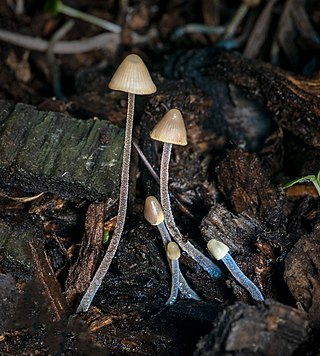
Mycena is a large genus of small saprotrophic mushrooms that are rarely more than a few centimeters in width. The name Mycena comes from the Ancient Greek μύκηςmykes, meaning "fungus". Species in the genus Mycena are commonly known as bonnets.

Octocorallia is a class of Anthozoa comprising over 3,000 species of marine organisms formed of colonial polyps with 8-fold symmetry. It includes the blue coral, soft corals, sea pens, and gorgonians within three orders: Alcyonacea, Helioporacea, and Pennatulacea. These organisms have an internal skeleton secreted by mesoglea and polyps with eight tentacles and eight mesentaries. As with all Cnidarians these organisms have a complex life cycle including a motile phase when they are considered plankton and later characteristic sessile phase.
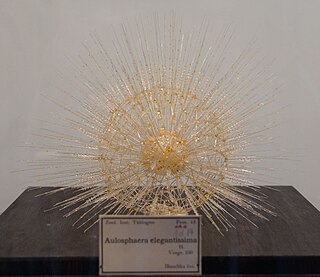
Aulosphaera is a genus of Cercozoa. The genus contains bioluminescent species. It one of two known bioluminescent phaeodarean genera, the other being Tuscaridium. The described bioluminescent species is Aulosphaera triodon Haeckel, 1887.
Siphonosphaera is a genus of radiolarians. The genus contains bioluminescent species. It is a genus of colonial radiolarians.
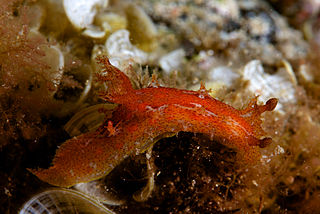
Plocamopherus is a genus of sea slugs, specifically nudibranchs, shell-less marine gastropod molluscs in the family Polyceridae, subfamily Triophinae. A unique character of Plocamopherus species is a globular bioluminescent organ at the tip of the pair of appendages which are placed just behind the gills. Many species are known to be nocturnal and several are from deep water. They feed on bryozoans.
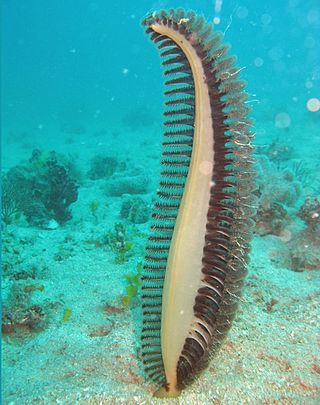
Pennatulidae is a family of sea pens, a member of the subclass Octocorallia in the phylum Cnidaria.

Cavernularia is a genus of marine cnidarians in the family Veretillidae.

Acrosphaera is a radiolarian genus in the Collosphaeridae. The genus contains bioluminescent species. It is a genus of colonial radiolarians.

Collosphaera is a radiolarian genus in the family Collosphaeridae. The genus contains bioluminescent species. It is a genus of colonial radiolarians.
Stachyptilum is a genus in the family Stachyptilidae. The genus contains bioluminescent species.

Umbellula is a genus of cnidarians in the monotypic family Umbellulidae. The genus contains bioluminescent species.

Veretillum is a genus in the family Veretillidae. The genus contains bioluminescent species.

Sinopyrophorus is a genus of bioluminescent hard-bodied clicking beetles in the superfamily Elateroidea, and is the sole member of the recently recognized family Sinopyrophoridae. The genus currently contains a single species, Sinopyrophorus schimmeli, which was described in 2019 from the subtropical evergreen broadleaf forests of western Yunnan, China.
